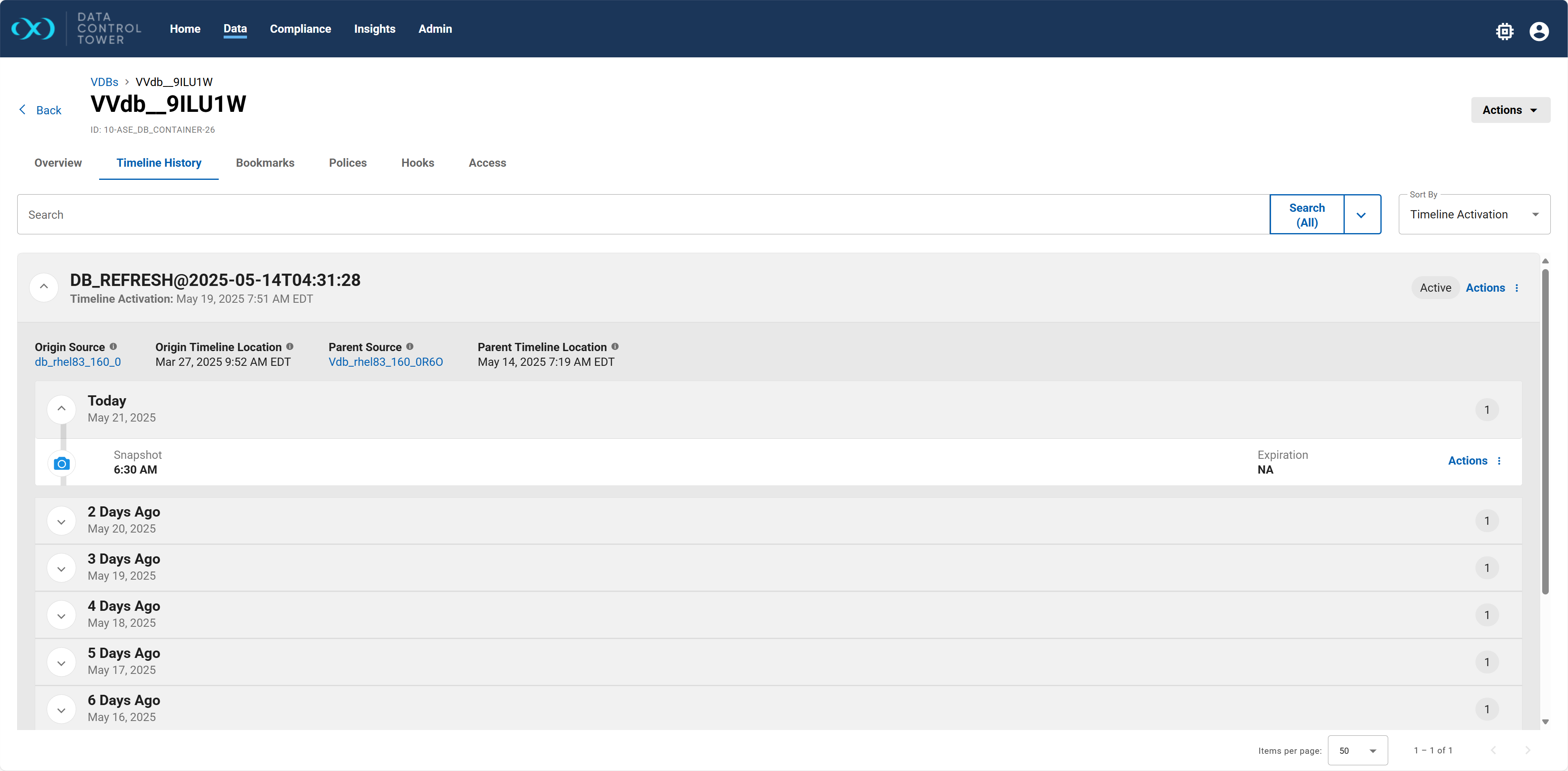Timelines in DCT
Introduction
Timelines in Data Control Tower (DCT) provide a visual and functional way to track the progression and state of Virtual Databases (VDBs) and dSources over time. The Timeline feature shows a chronological view of key events in a VDB’s lifecycle—such as creation, data refreshes, and operational changes—and records them with timestamps for historical reference.
Each event is represented as a row on the VDB’s Timeline History page, located in the detail page of a VDB. On the backend, every snapshot is saved as a dedicated folder of data. When changes occur (e.g., during a refresh), a new folder is created that points back to the original snapshot, forming a continuous chain of changes.
Recent updates to DCT introduce revised terminology, a streamlined interface, improved sorting functionality, and powerful new search capabilities.
Prerequisites
To utilize Timelines, you must register a Continuous Data Engine with DCT and create a dSource or VDB.
Common use cases
Timelines are designed to support a range of common data management workflows, including:
-
Viewing complete history: See the full history of a VDB or dSource, including snapshots and bookmarks, in a single Timeline view.
-
Re-activating test cases: Continue working on older test cases by re-activating their Timelines.
-
Point-in-time recovery: Refresh a VDB to an earlier point in time or switch to a different Timeline as needed.
-
Bookmarking snapshots: Mark notable snapshots to share with colleagues or for future reference.
Terms and UI changes
-
The term Timeflow has been updated to Timeline throughout the application, making terminology more intuitive and aligned with its functionality.
-
dSource groupings by time, previously found in the Timeline History view, have been removed for a cleaner, more streamlined presentation.
Navigating and exploring Timelines
The Timeline view is designed to help quickly identify the information you need, whether tracking down a specific event or evaluating a VDB's entire history. DCT also provides robust sorting and search capabilities to support this effort. Learn more about these capabilities below.
Flexible sorting
The top of the Timeline page has a new Sort By dropdown that lets you reorganize Timelines based on needs. Those options are as follows.
-
Timeline Activation (default): Orders Timelines by their activation timestamp so that the active Timeline is displayed prominently at the top.
-
Timeline Creation: Orders Timelines by their creation timestamp.
-
Parent Timeline Location: Orders Timelines by the timestamp of their parent Timeline, from which the data was refreshed.
-
Origin Timeline Location: Orders Timelines by the timestamp that indicates where the original data (or dSource) is from.
Contextual metadata
Timeline metadata updates dynamically based on the sort selection. Timestamps and other details are shown in clear (human-readable) formats, such as, “Timeline Activation: \<time\>”—which makes it easier to follow changes.
Powerful search
The integrated search bar allows you to pinpoint specific snapshots or activities based on the Timeline's top-line metadata. This helps improve efficiency for locating specific Timelines or activities within DCT.
Unified view
Bookmarks and Snapshots now appear together within each Timeline, so all relevant context and historical records are accessible from a single page. As of DCT version 2025.3, individual Timelines can also be deleted from this view.
Feature limitations
-
Connectivity issues: If engine connectivity is lost, DCT cannot determine whether a Timeline is active or record its activation time. These cases result in a "not available" message.
-
Renamed Timelines: Timeline creation time is inferred from its default name. If a Timeline is renamed, DCT cannot determine its original creation time. These cases result in a "not available" message.
-
Engine timezone changes: Timeline creation times are interpreted in the Continuous Data Engine’s timezone. If the engine’s timezone changes, these times may no longer be accurate.


